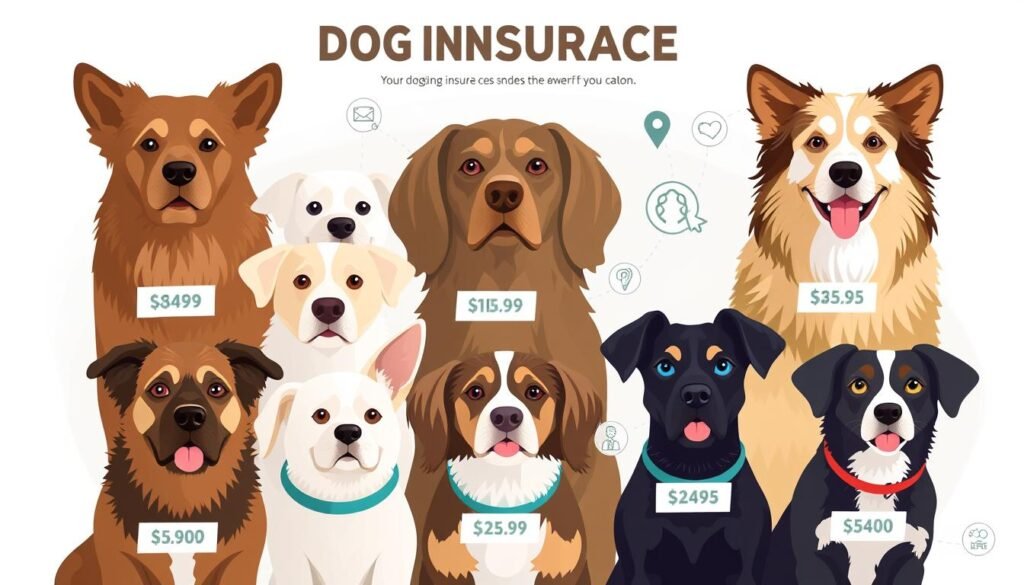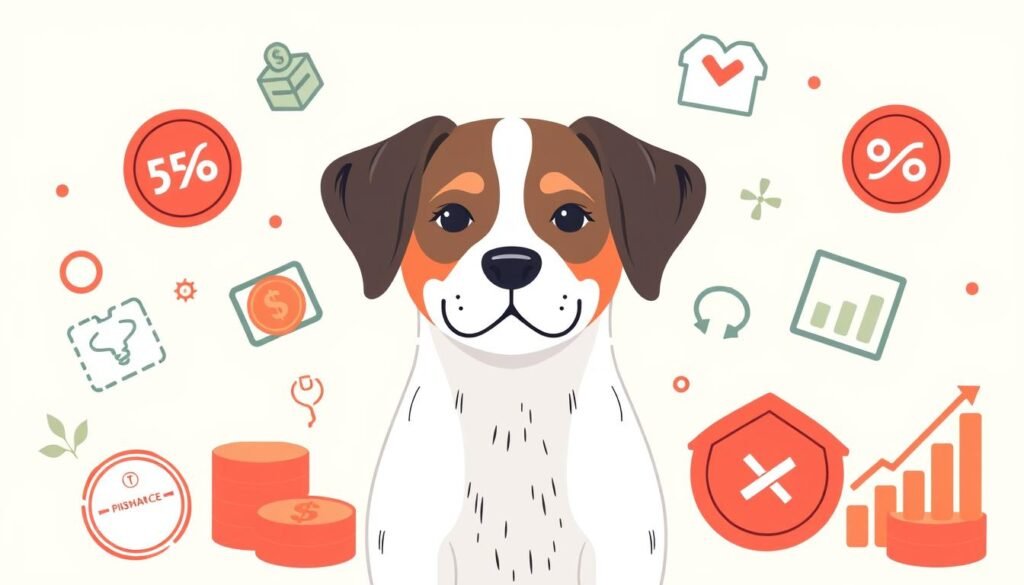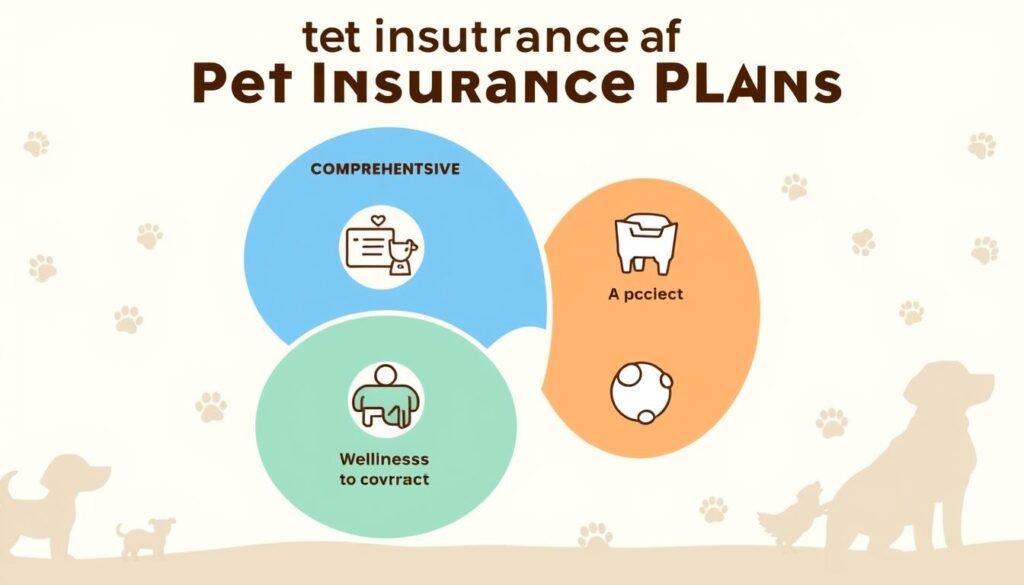How Much Does Dog Insurance Really Cost? 7 Factors That Influence Your Premiums
Pet insurance is a popular choice for dog owners to protect their pets. But, have you ever thought about the cost of dog insurance? The truth is, the cost can change a lot based on different factors. In this guide, we’ll look at the main things that affect your dog’s insurance costs. This will help you choose a plan that’s right for your budget and your dog’s needs.
Key Takeaways
- The average accident and illness plan pet insurance premium for dogs is $53.34 per month1.
- Accident-only pet insurance for dogs averages $16.70 per month1.
- Cats are typically less expensive to insure than dogs1.
- Premiums can vary based on factors like location, breed, age, and coverage amount1.
- Pet insurance plans typically reimburse a percentage of out-of-pocket costs1.
Understanding the Basics of Pet Insurance Premiums
Pet insurance premiums are the monthly or yearly payments for your pet’s coverage. The cost varies based on your pet’s age, breed, species, and where you live2. In 2023, the average annual cost for a policy was $676 for dogs and $383 for cats3. Accident-only policies are cheaper, costing $204 for dogs and $116 for cats annually3.
What Are Insurance Premiums?
Insurance premiums are the fees you pay for your pet’s medical expenses coverage. These payments help you have coverage for unexpected vet bills4.
How Premium Calculations Work
Your pet’s insurance premiums depend on several factors. These include your pet’s age, breed, species, and location4. Older pets and larger animals often have higher medical costs, leading to higher premiums4. Where you live also affects premium costs due to different vet care prices4.
Types of Coverage Available
You can choose from accident and illness coverage, accident-only coverage, or wellness plans3. The type of coverage you pick affects your premium. Higher reimbursement and lower deductibles mean higher premiums, while lower reimbursement and higher deductibles mean lower premiums4.
Understanding pet insurance premiums helps you choose the right coverage for your pet. By considering your pet’s age, breed, and location, you can find a policy that fits your budget2. With over 5.6 million insured pets in the U.S. as of 2023, pet insurance is becoming more popular2.
Cost of Dog Insurance: National Averages and Statistics
The cost of dog insurance varies based on several factors. The North American Pet Health Insurance Association (NAPHIA) reports an average monthly premium of $49.51 for dogs and $28.48 for cats5.
Looking at past data, dog insurance premiums have been steady. In 2020, they were $49.51, and in 2016, they were $43.135. Today, the average monthly cost for dogs is about $53, while accident-only plans cost $16.706.
Insurance costs also differ by state. For example, a puppy in Alabama costs $39.43, while in California, it’s $56.565. Cat insurance costs range from $18.22 in Wyoming to $35.80 in California5.
| Breed | Average Monthly Cost | Average Annual Cost |
|---|---|---|
| Labrador Retriever | $35.52 | $426.24 |
| Golden Retriever | $51.34 | $616.08 |
| French Bulldog | $78.16 | $937.92 |
| Bernese Mountain Dog | $125.18 | $1,502.16 |
| Rottweiler | $295.95 | $3,551.40 |
Pet insurance costs can vary a lot. The average premium is $94.13 per month, with a $500 deductible and 80% reimbursement6. Costs depend on breed, age, location, and more5.
Reimbursement rates, deductibles, and coverage limits affect costs. Higher reimbursement rates mean lower costs5. Premiums can also change based on breed and age6.

In summary, dog insurance costs vary a lot. Monthly premiums range from $16 to $536. The average annual cost is about $1,058, with a monthly average of over $886. Knowing what affects these costs helps pet owners choose the best insurance56.
The Impact of Location on Insurance Rates
Where you live greatly affects the cost of dog insurance. State-by-state and urban vs. rural differences play a big role. This means where you are can change how much you pay for pet insurance7.
State-by-State Premium Variations
Pet insurance costs vary a lot by state. Louisiana has the lowest average premium at $45.85 per month. New York has the highest at $84.07 per month7. The cost of living, vet care, and health risks in each state affect these rates7.
Urban vs. Rural Cost Differences
People in big cities like New York or San Francisco pay more for insurance. This is because vet care costs more in cities8. The cost of living, including medical costs, also affects insurance prices9.
Regional Veterinary Care Costs
Insurance companies look at local vet care costs to set premiums. For example, Los Angeles has higher vet visit fees than Sioux City, Iowa. This is because of the cost of living differences9. These regional medical cost variations are key in setting dog insurance rates8.

In summary, where you live greatly affects your dog’s insurance cost. State-specific and urban vs. rural differences are important. Knowing these can help you choose the best pet insurance plan7.
Breed-Specific Premium Variations
The breed of your dog can greatly affect your insurance costs. Some breeds are more likely to get certain health problems, making insurance more expensive10. For example, Bulldogs often have breathing issues, skin problems, and eye issues, leading to higher premiums10. Great Danes, being large, face higher risks of health problems like hip issues and heart disease, also increasing costs10.
Other high-cost breeds include Rottweilers, German shepherds, and Golden retrievers. These dogs are more likely to have health issues like cancer and hip problems, raising insurance prices10. On the other hand, mixed-breed dogs and Jack Russell terriers usually have lower premiums because they are generally healthier10.
Knowing about these breed-specific factors is crucial when choosing a dog and considering insurance11. There are many cat and dog breeds worldwide, each with its own health risks and insurance costs11. Understanding these can help you prepare for the costs of owning a pet11.

The cost of dog insurance varies a lot based on the breed11. Being aware of these variations helps you budget for pet care. This way, you can ensure your dog gets the care they need without overspending11.
| Dog Breed | Average Monthly Premium |
|---|---|
| Labrador Retriever | $52 |
| French Bulldog | $75 |
| German Shepherd | $46 |
| Golden Retriever | $52 |
| Bulldog | $69 |
| Poodle | $55 |
| Beagle | $45 |
| Rottweiler | $78 |
| Australian Shepherd | $39 |
| Yorkshire Terrier | $31 |
Age as a Key Price Factor
The age of your dog greatly affects the cost of pet insurance12. Younger, healthier dogs are less expensive to insure13. As dogs get older, their risk of illness goes up, leading to higher premiums12.
Puppy Insurance Costs
Insuring a puppy can be more affordable13. You can start insurance as early as 7 or 8 weeks old13. But, premiums will likely go up as your puppy grows and faces more health risks.
Adult Dog Coverage Expenses
Adult dogs cost more to insure than puppies12. Premiums vary by breed and location. Expect to pay $30 to $71 monthly for basic coverage14. More comprehensive plans can cost $36 to $101 monthly14.
Senior Dog Insurance Considerations
Senior dogs see a big jump in insurance costs12. Some insurers, like PHI Direct, keep deductibles the same as dogs age12. This can help manage the higher costs of insuring older dogs12. When picking a policy, think about how age affects premiums to find the right one for your budget and dog’s needs.

The age of your dog is a major factor in pet insurance costs12. Knowing how premiums change with age helps you choose wisely. This way, you can protect your dog without spending too much.
Customizing Coverage: Deductibles and Reimbursement Rates
Pet insurance costs can change a lot based on how much coverage you pick. Two main things that affect the cost are the deductible and how much the insurance pays back15.
Deductibles for pet insurance can be as low as $50 or as high as $2,500. This depends on what you need and how much you can spend15. If you choose a higher deductible, your monthly payments will be lower. But, you’ll have to pay more for vet bills before the insurance helps. Lower deductibles mean you pay more each month but less when you need to use the insurance15.
Reimbursement rates are also key in figuring out the cost of dog insurance. Most plans offer to pay back 70% to 100% of vet bills after you’ve paid the deductible16. The more your insurance covers, the higher your premium will be17.
| Deductible | Reimbursement Rate | Impact on Premiums |
|---|---|---|
| $50 – $2,500 | 70% – 100% | Higher deductibles and lower reimbursement rates typically result in lower monthly premiums, but higher out-of-pocket expenses when filing a claim. |
By adjusting your deductible and reimbursement rate, you can balance your monthly costs and what you might have to pay out of pocket. This lets you customize your pet insurance to fit your needs and budget17.

It’s a good idea to check your pet’s insurance often and make changes if needed. This way, you can make sure you’re getting the best deal while still giving your pet the care they need17.
Understanding Policy Limits and Their Effect on Cost
The coverage limits you pick can really change how much you pay for pet insurance18. Insurance companies have different annual limits, from $2,500 to over $15,00018. Nationwide is the only one with a plan that has yearly limits for conditions18.
Pets Best will pay up to $30 a year for heartworm prevention in cats and dogs18. Emergency visits can cost thousands, and cancer treatment can go over $15,00018.
Annual Coverage Caps
Many policies have yearly caps on how much they’ll pay out18. Some plans offer unlimited coverage, with no limit on claims18. Unlimited coverage costs more but gives you peace of mind for your pet’s health18.
Lifetime Coverage Options
Some policies also have lifetime limits, capping the total payout for your pet’s life18. When picking limits, think about your pet’s vet costs and make sure the policy covers enough1819. It’s key to check and update your limits as your pet’s needs change19.
Pawlicy Advisor helps you compare policies by looking at limits, deductibles, and how much they’ll pay back18.

Available Discounts and Cost-Saving Opportunities
Having a dog can be expensive, but there are ways to cut costs. Many insurance providers offer discounts to help lower your premiums. Multi-pet discounts, for example, can save you about 10% for each additional pet20. Some companies also give discounts if you pay yearly instead of monthly20.
When looking for pet insurance, it’s smart to compare different providers and their discounts20. Your pet’s age, breed, and where you live can affect the cost. So, finding the right discounts and coverage is crucial for saving money20.
- Explore multi-pet discounts, which can save you around 10% for additional pets.
- Look for annual pay discounts, which offer savings compared to monthly payments.
- Check if your employer, veterinarian, or other affiliations offer pet insurance discounts.
- Consider accident-only plans as a more affordable alternative to comprehensive coverage.
By using these savings tips, you can lower your dog’s insurance costs. This way, you can protect your pet without spending too much2120.

| Discount Type | Average Savings |
|---|---|
| Multi-pet discount | 10% |
| Annual pay discount | Varies by provider |
| Employee/veterinarian discount | Varies by provider |
| Accident-only plan | Lower premiums than comprehensive |
Comparing Different Types of Coverage Plans
Choosing the right pet insurance plan can be tough. There are many types, from accident-only to accident and illness plans. Each has different costs and benefits22. You can also add wellness plans for routine care, making your pet’s health care more complete22.
Accident-only plans are cheaper but only cover unexpected injuries22. Accident and illness plans are more expensive but cover a lot more, like breed-specific conditions and dental care22. These plans offer more financial security and peace of mind22.
When looking at plans, think about deductibles, how much you get back, and monthly costs22. Also, how fast the provider pays out claims is important22. For example, Embrace Pet Insurance paid 92% of claims in 2021 and offers up to 90% reimbursement22.
To pick the right plan, compare coverage and costs carefully23. Some, like ASPCA and Pets Best, pay claims quickly, often in five days or less22. Others, like Figo, offer 100% reimbursement after the deductible22.
The best plan balances your pet’s health needs and your budget23. Knowing what each plan offers helps you choose the best protection for your pet23.

The True Value of Pet Insurance Investment
Understanding the value of pet insurance is key. It’s about comparing the cost of unexpected vet bills to the monthly premium. While dog insurance costs about $47 a month24, it offers great protection, especially in emergencies.
Cost vs. Benefits Analysis
Pet insurance that covers accidents and illnesses can save you a lot of money. The average annual cost for such coverage is $594 for dogs25. This might seem expensive, but think about vet visits costing around $7026. Most policies pay 70% to 90% of these costs26, making it a worthwhile investment.
Emergency Care Coverage Benefits
Emergencies can happen to any pet, with one in three needing urgent care24. The cost of these emergencies can be high, with insurance policies costing $22 to $100 monthly24. A good insurance plan means you won’t face huge vet bills alone if an emergency happens.
FAQ
What are insurance premiums?
Insurance premiums are the monthly payments pet owners make for pet insurance coverage. These payments transfer the financial risk from the pet owner to the insurance company.
How do pet insurance premium calculations work?
Premium calculations look at your pet’s age, breed, location, and coverage type. These factors affect the risk and cost of care, which changes your monthly premium.
What types of pet insurance coverage are available?
There are mainly three types: accident and illness, accident-only, and wellness plans. Accident and illness plans offer the most coverage. Accident-only and wellness plans provide less coverage but cost less.
What are the average monthly costs for dog insurance?
The average monthly premium for dog accident and illness coverage is .34. Accident-only coverage costs about .70 a month. But, costs vary based on your pet’s details and coverage.
How does location impact pet insurance premiums?
Location is a big factor. Insurance companies consider regional veterinary care costs. Premiums are often higher in cities than in rural areas.
Do certain dog breeds have higher insurance premiums?
Yes, some breeds have higher premiums due to health issues. Insurance companies charge more for breeds with conditions like hip dysplasia or eye problems.
How does my pet’s age affect the cost of insurance?
Older pets have higher premiums because of health risks. Puppies have lower premiums, but they increase with age. Some providers keep deductibles the same as pets age.
How do deductibles and reimbursement rates impact premium costs?
Higher deductibles mean lower monthly premiums but more out-of-pocket costs. Reimbursement rates, from 70% to 90%, also affect premiums. Adjusting these can balance costs and expenses.
How do policy limits affect the cost of pet insurance?
Higher coverage limits mean higher premiums. Coverage caps usually range around ,000. Some policies offer unlimited coverage. Choose limits based on your vet costs for protection.
Are there any discounts available to lower pet insurance premiums?
Yes, many providers offer discounts. Common discounts include multi-pet and annual payment discounts. Looking at different providers can help find the best deals.
How do the different types of coverage plans compare in terms of cost?
Accident-only plans are cheaper than comprehensive plans. Wellness plans add extra coverage for routine care but cost more. Compare costs and coverage to find the best fit for your pet and budget.
What is the true value of investing in pet insurance?
Consider vet costs against premium expenses to find the value. Pet insurance offers peace of mind and financial protection for emergencies. Weigh costs and benefits to decide if it’s worth it for your pet.
Source Links
- How Much Is Pet Insurance: Average Costs
- Is Pet Insurance Worth It? 2024 Guide – NerdWallet
- How Much Does Pet Insurance Cost? – Experian
- Everything You Need to Know About Pet Insurance Premiums
- Average Pet Insurance Cost in 2022 by Breed, Age, & State
- What It Costs to Protect Your Pup With Dog Insurance
- Pet Insurance Breakdown by State [Original Research]
- What Causes Pet Insurance Premiums To Increase Over Time? | Bankrate
- Why Does My Location Affect Pet Insurance Costs?
- How Dog Breed Affects The Cost Of Your Pet Insurance Premium | Bankrate
- How Does Breed Impact a Pet Insurance Policy? | Spot®
- What Factors Impact Your Pet Insurance Premiums?
- What is the best age to get pet insurance?
- How Much Does Pet Insurance Cost? | Bankrate
- Pet Insurance Deductibles Explained | MetLife Pet Insurance
- What Is Pet Insurance, How Does It Work & What Is Covered? A Pet Parent’s Guide
- How to Customize Your Pet Insurance Coverage | PetPlace.com
- Pet Insurance Annual Limit: What It Means & Why It Matters
- Guide to Determining Policy Limits for Canine Liability Insurance | Dog Bite Insurance
- Cheapest pet insurance companies in 2024
- Best Pet Insurance Companies for December 2024 – NerdWallet
- How to Compare Pet Insurance Plans & Find The Best Fit
- Comparing Types of Pet Insurance | ASPCA Pet Health Insurance
- Is Pet Insurance Worth It? 2024 Experts Answer
- Is Pet Insurance Worth It?
- Is Pet Insurance Worth It? A Comprehensive Guide
editor's pick
latest video
news via inbox
Nulla turp dis cursus. Integer liberos euismod pretium faucibua

